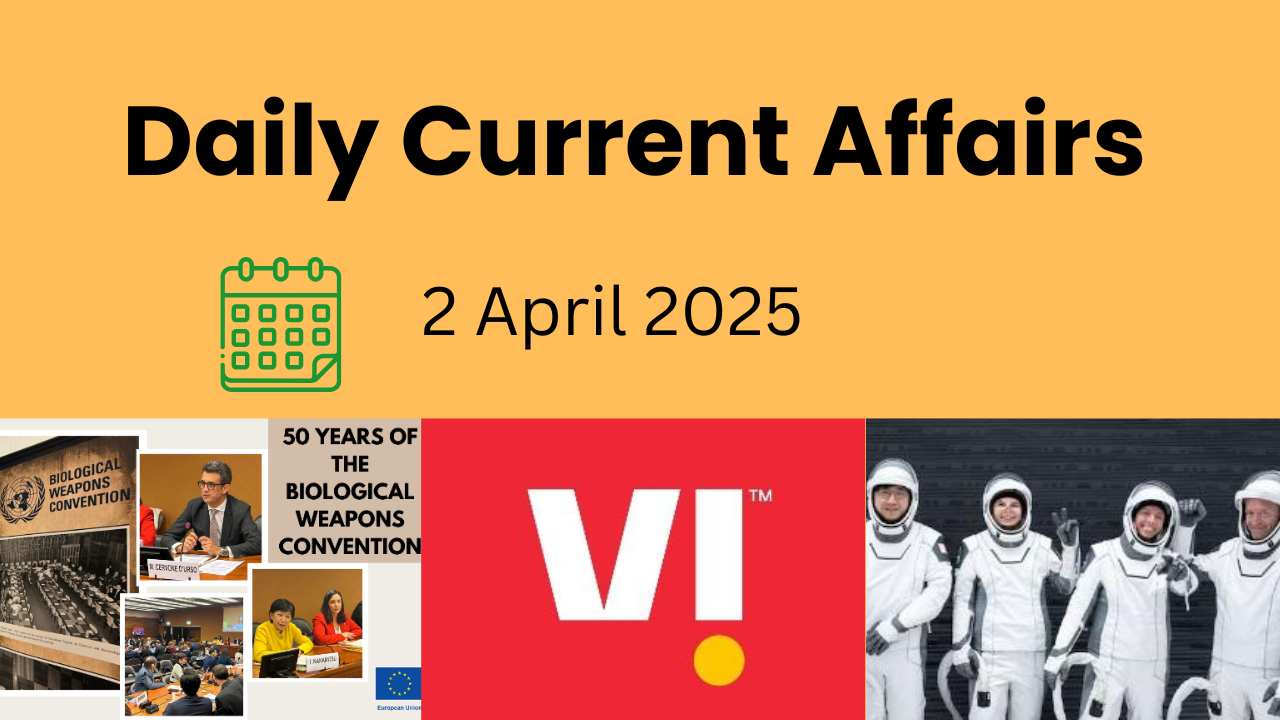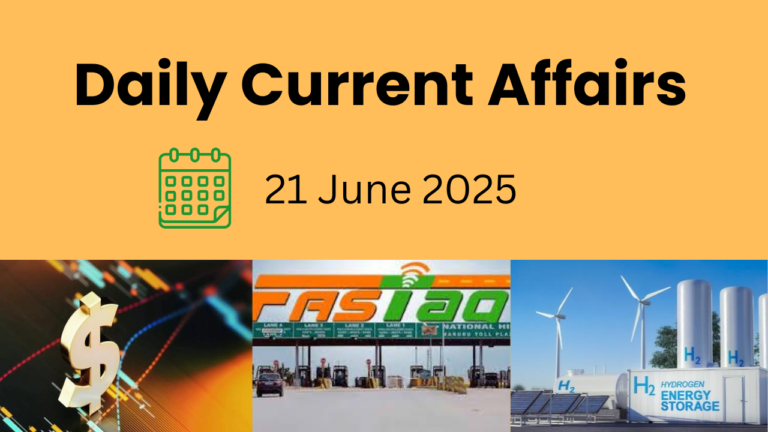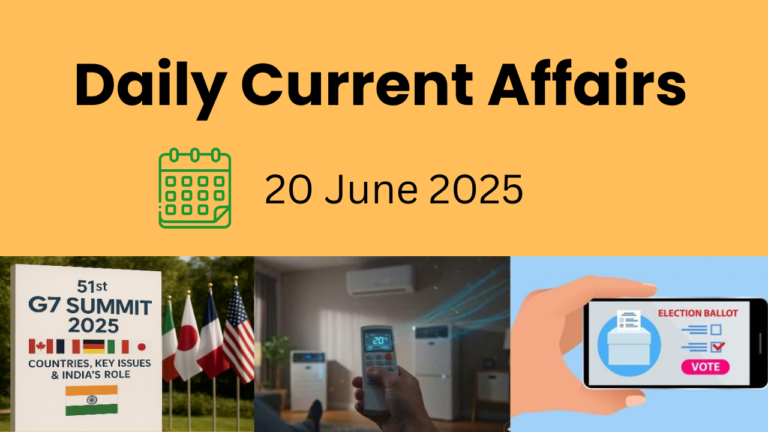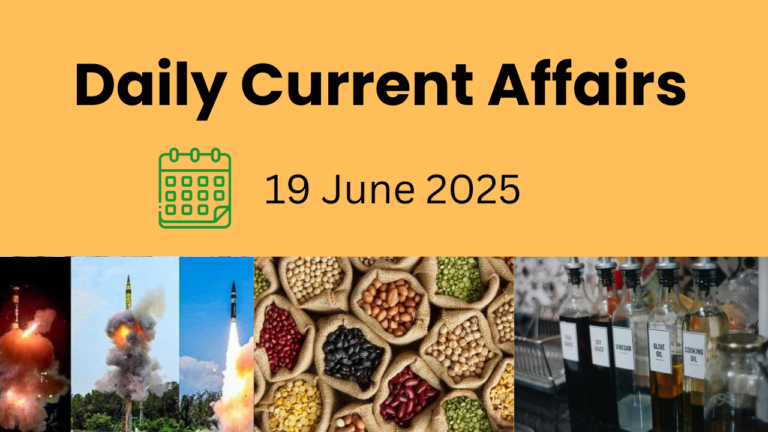1. Historic Polar Orbit Mission: SpaceX Achieves a Groundbreaking Feat
Context: SpaceX recently made history with the successful launch of Fram2, a private astronaut crew mission aboard a Falcon 9 rocket from NASA’s Kennedy Space Center in Florida. This mission marks a pivotal milestone as the first human spaceflight to utilize a polar orbit trajectory—an achievement that expands the boundaries of human space exploration.
What is a Polar Orbit?
A Polar Orbit (PO) is a specific type of Low Earth Orbit (LEO), typically ranging between 200 km to 1,000 km in altitude. Unlike equatorial orbits that circle the Earth from west to east, polar orbits travel from pole to pole, allowing satellites to cross over every part of the Earth’s surface over time.
Interesting Fact: A deviation of up to 10 degrees from the exact North-South trajectory is still classified as a polar orbit.
Why Polar Orbits Matter:
Polar orbits are crucial for:
- Global Earth Observation: They provide comprehensive, repeated coverage of the entire Earth’s surface as the planet rotates beneath the satellite’s path.
- Climate Monitoring: Vital for tracking changes in the atmosphere, oceans, and land surfaces, polar orbits are essential for understanding climate change.
- Reconnaissance Missions: Governments and private entities use polar orbits for high-resolution imaging and surveillance.
Did You Know? Most Earth observation satellites, like those in the Landsat program, utilize polar orbits for detailed monitoring of environmental changes.
Significance of the Fram2 Mission:
- First Human Spaceflight in Polar Orbit: Unlike traditional missions that follow equatorial orbits, Fram2 travels from pole to pole. This trajectory enables complete observation of Earth’s surface over time, making it invaluable for climate studies, global surveillance, and research.
Fact: Prior to Fram2, polar orbits were almost exclusively used by Earth-observing satellites and reconnaissance missions—not human missions. - Expanding Commercial Spaceflight: Fram2 is SpaceX’s sixth private astronaut mission, further solidifying its dominance in the commercial spaceflight sector. By demonstrating the feasibility of polar-orbiting human missions, SpaceX highlights the growing role of private companies in space exploration, reducing reliance on government agencies like NASA.
- Reusable Spacecraft Innovation: The mission uses the Crew Dragon capsule, a reusable spacecraft developed by SpaceX with NASA funding. To date, SpaceX has successfully conducted 16 crewed missions with this capsule, proving the cost-efficiency and reliability of reusable technology.
Fact: Reusability reduces the cost of space missions by up to 70%, a game-changer for making space travel more accessible.
Future Implications:
The success of the Fram2 mission signals a new era of space exploration, where commercial entities push the boundaries of technology and trajectory. With the ability to explore polar orbits, we can expect enhanced global monitoring, improved climate models, and expanded human missions to previously inaccessible orbits.
2. Abel Prize 2025: Celebrating Mathematical Excellence
Context: The Abel Prize is a prestigious international award recognizing groundbreaking contributions to the field of mathematics. Established by the Norwegian Parliament in 2002 to mark the 200th anniversary of the birth of the brilliant Norwegian mathematician Niels Henrik Abel (1802-1829), the prize has become a highly coveted honor in the mathematical community.
Often regarded as the “Nobel Prize of Mathematics,” the Abel Prize fills the void left by the absence of a mathematics category in the Nobel Prizes. It carries a monetary award of 7.5 million kroner (approximately $720,000) and a glass plaque crafted by Norwegian artist Henrik Haugan.
The award is managed by the Norwegian Academy of Science and Letters on behalf of the Norwegian government. Recipients are selected by a specialized committee appointed by the Academy with guidance from the International Mathematical Union (IMU) and the European Mathematical Society (EMS).
Abel Prize 2025 Winner: Masaki Kashiwara
This year, the Abel Prize has been awarded to Masaki Kashiwara, a Japanese mathematician whose pioneering work has profoundly transformed algebraic analysis, representation theory, and sheaf theory.
Kashiwara’s most celebrated contributions include:
- Development of the Theory of D-Modules: A framework essential for understanding systems of differential equations and their solutions.
- Discovery of Crystal Bases: A revolutionary approach that simplifies complex algebraic calculations by replacing them with graphs of vertices and edges. This has become a powerful tool in representation theory and has led to significant advancements in understanding symmetries in mathematical structures.
His work has bridged previously unconnected areas of mathematics, creating new pathways for future research and contributing to solving longstanding, challenging problems.
The Significance of Masaki Kashiwara’s Work:
- Crystal Bases and Quantum Groups: Kashiwara’s discovery of crystal bases provided a fundamental structure within the theory of quantum groups, which play a crucial role in both pure mathematics and theoretical physics.
- D-Modules: His theory of D-modules has applications beyond mathematics, influencing areas such as string theory, algebraic geometry, and representation theory.
- Collaborations and Influence: Kashiwara’s work has inspired numerous mathematicians worldwide, contributing to a deeper understanding of algebraic structures and their applications.
Did You Know?
- Niels Henrik Abel, after whom the prize is named, died at the age of 26 but made monumental contributions, including proving the impossibility of solving general quintic equations by radicals.
- The Abel Prize is often compared to the Fields Medal, but unlike the Fields Medal, which is awarded every four years to mathematicians under the age of 40, the Abel Prize has no age restriction and is awarded annually.
Legacy and Future Impact:
Masaki Kashiwara’s contributions continue to inspire new research and drive innovation in mathematics. His breakthroughs have not only resolved deep mathematical puzzles but also established tools that future generations of mathematicians will build upon.
The Abel Prize 2025 stands as a testament to Kashiwara’s brilliance, dedication, and vision, solidifying his legacy as one of the foremost mathematicians of our era.
3. Tensions Rise in the Arctic as Global Powers Compete for Strategic Control
Context: The Arctic, once a frozen and remote region, has quickly become a strategic hotspot on the global stage. Climate change is causing the ice caps to melt at an unprecedented rate, opening up new trade routes and revealing vast untapped natural resources. These developments have led to increased interest from major powers, intensifying the competition for control of this critical region. If tensions are not managed properly, the Arctic could become a focal point for military conflicts and political struggles.
Why the Arctic Matters: Strategic and Economic Value:
- Natural Resources: The Arctic is home to 13% of the world’s undiscovered oil and 30% of its untapped natural gas reserves. It also boasts rich deposits of rare earth elements, copper, and phosphates, and is crucial for fishing industries. These resources, long buried under ice, are now becoming accessible due to global warming.
- New Shipping Routes: The melting ice is opening up vital new shipping lanes, like the Northeast Passage along Russia’s Arctic coast. This route could reduce travel time between East Asia and Europe by nearly 8,000 km, making it a game-changer for global trade. China is particularly invested in this opportunity, proposing the creation of a “Polar Silk Road” to bypass traditional chokepoints such as the Suez Canal.
Legal Framework and Territorial Disputes:
Unlike the Antarctic—which is governed by an international treaty system—the Arctic’s territorial disputes are handled under the United Nations Convention on the Law of the Sea (UNCLOS). Nations can claim seabed areas beyond their 200-nautical-mile Exclusive Economic Zones (EEZs) if they can prove geological continuity with their continental shelf.
- The Arctic Council consists of eight nations: U.S., Canada, Russia, Denmark (via Greenland), Norway, Sweden, Finland, and Iceland. Although the Council aims to promote environmental protection and scientific collaboration, geopolitical rivalries have placed significant strain on its cohesion.
- Nations like Canada, Denmark, and Russia have submitted overlapping claims to the UN Commission on the Limits of the Continental Shelf. If these claims are approved, countries could gain control over vast portions of the Arctic seabed.
Key Points of Tension in the Arctic:
- U.S. and Canada Dispute: The Northwest Passage, a potential shortcut for shipping, is a major flashpoint. Canada claims it as its internal waters, while the U.S. insists it’s an international strait, emphasizing the right to freedom of navigation. This ongoing disagreement adds to tensions between the two neighboring countries.
- Greenland’s Strategic Importance: Former U.S. President Donald Trump’s attempt to buy Greenland from Denmark sparked controversy, especially given the Pituffik U.S. military base located there. This move raised alarm bells in Denmark and Europe, leading to strengthened security commitments.
- Russia’s Assertiveness: Russia has the most advanced Arctic infrastructure, including the world’s only nuclear-powered icebreaker fleet. It has also revived several Soviet-era military bases and planted its flag on the Arctic seabed during a 2007 submarine expedition. Russia’s claims over parts of the Svalbard Islands, which belong to Norway, have further fueled tensions with NATO allies.
- NATO’s Growing Presence: The admission of Sweden and Finland into NATO has shifted the balance in Arctic geopolitics. NATO now conducts military exercises near Russian borders, increasing the military stakes in the region.
- China’s Arctic Ambitions: Despite not being an Arctic nation, China has declared itself a “Near-Arctic State” and is actively pursuing Arctic shipping routes. China’s collaboration with Russia, including joint naval drills, demonstrates the growing strategic ties between the two nations, which alarms Western powers.
Broader Implications for Global Security:
The Arctic’s strategic value extends far beyond its natural resources. As global powers vie for control of the region, it is becoming a high-stakes arena for energy politics, military posturing, and trade competition.
- The absence of clear legal frameworks and the limited scope for multilateral cooperation raise the risk of conflict.
- Environmental concerns are also critical. Increased shipping and drilling activities could accelerate the ecological degradation of the Arctic, which is already under immense stress due to climate change.
Conclusion: The Arctic as the New Global FrontierAs the ice retreats, the Arctic is rapidly becoming a center of geopolitical rivalry. Nations are eager to stake their claims to its energy resources and shipping lanes. The potential for conflict looms large, and without robust international cooperation, the Arctic could evolve into a major flashpoint in a world that is becoming increasingly multipolar.
4. Government Increases Stake in Vodafone Idea: Equity Conversion and AGR Dues
Context: The Indian government is set to increase its stake in Vodafone Idea (Vi) to nearly 49% by converting an additional 36,950 crore of the company’s dues into equity. This move significantly boosts the government’s stake, up from its previous holding of about 23%, making it the largest shareholder. However, the promoters will retain operational control of the company. Vi will issue 3,695 crore shares at 10 per share—47% above its market price of 6.8. These dues primarily cover spectrum auction payments and deferred liabilities after the moratorium period.
Background: Vodafone Idea and AGR Issue
AGR Dues and Legal Struggles :
Vodafone Idea (Vi) has faced significant financial burdens due to a ruling by the Supreme Court on Adjusted Gross Revenue (AGR) dues. AGR determines the portion of revenue telecom operators must share with the government, including charges for spectrum usage and licensing.
- AGR Controversy: The Department of Telecom (DoT) mandates that AGR includes all revenues, including non-telecom sources like deposit interest and asset sales. Telecom companies have contested this, arguing AGR should only encompass telecom service revenues.
- Supreme Court Ruling: In October 2019, the Supreme Court ruled in favor of the government, expanding AGR to include all revenues except termination fees and roaming charges. This decision placed a massive financial strain on telecom operators.
- Final Ruling (2020): On September 1, 2020, the Court upheld the government’s definition of AGR and directed companies to clear their dues, including interest and penalties. The payment schedule was set from April 2021 to March 2031. Defaults would lead to penalties and contempt of court.
Government Relief Measures and the Lifeline for Vodafone Idea:
Telecom Reform Package (2021) :
In September 2021, the Union Cabinet approved a telecom reforms package designed to ease the burden on telecom operators and improve liquidity. Key measures included:
- A four-year moratorium on spectrum and AGR dues (set to end in October 2025).
- A one-time option to convert interest on deferred payments into equity after the moratorium period.
Second Lifeline for Vodafone Idea:
To further aid Vodafone Idea, the government converted 16,000 crore of interest liabilities into equity in February 2023, increasing its stake to 33.1%. With this latest conversion, the government’s stake in Vi will rise to 49%, helping the company manage its massive debt burden.
Vodafone Idea’s Debt Burden:
As of December 2024, Vi’s total debt is approximately 2.3 lakh crore, comprising:
- 77,000 crore in AGR liabilities.
- 1.4 lakh crore in spectrum liabilities.
Despite the equity conversion, the company still faces immense debt, with no new capital infusion from this move.
Impact of Equity Conversion on Vodafone Idea:
- Debt Relief and Financial Runway : The conversion of debt into equity helps Vi reduce its spectrum dues, preventing an immediate financial crisis. Without this intervention, the company would have faced an annual installment of 40,000 crore post-September 2025. This relief is expected to provide Vi with a financial runway for two more years.
- Limited Debt Reduction: While this move reduces the debt by 37,000 crore, Vi’s total debt remains high at 2.1 lakh crore. However, there is no fresh capital infusion, meaning existing shareholders face further dilution of their holdings.
- Government Ownership Limit : The government’s equity stake cannot exceed 50%. Beyond this threshold, Vi would be classified as a Public Sector Undertaking (PSU). This ownership limit prevents the government from converting more debt into equity without fundamentally changing the company’s structure.
- Potential for Raising New Debt: With increased government ownership, Vi may gain increased confidence from investors and banks, making it easier for the company to raise the 25,000 crore in new debt it seeks to secure.
Conclusion: A Mixed Outlook for Vodafone Idea
The government’s equity conversion has provided Vodafone Idea with some much-needed financial breathing room, though its future remains uncertain. The company’s ability to raise new debt and manage its overwhelming liabilities will determine whether this lifeline proves sustainable or if further support will be required. For now, the government’s increased stake has provided a temporary reprieve, but long-term financial stability will depend on Vi’s operational performance and ability to navigate its substantial debt load.
5. Commemorating the 50th Anniversary of the Biological Weapons Convention (BWC)
Context: The Biological Weapons Convention (BWC), marking its 50th anniversary in 2025, stands as the first multilateral treaty to fully ban a class of Weapons of Mass Destruction (WMDs). The treaty was opened for signature in April 1972 and officially entered into force on March 26, 1975.
Understanding the Biological Weapons Convention (BWC)
Full Name and Purpose : Formally titled, “The Convention on the Prohibition of the Development, Production, and Stockpiling of Bacteriological (Biological) and Toxin Weapons and on their Destruction,” the BWC is a critical component in the global effort to prevent the use of biological and toxin weapons.
Definition of Biological and Toxin Weapons:
Biological and toxin weapons are either microorganisms such as viruses, bacteria, or fungi, or toxic substances naturally produced by living organisms. These weapons are deliberately engineered and released to cause disease and death in humans, animals, or plants.
Examples of Biological Weapons
- Anthrax
- Botulinum toxin
- Plague
Potential Consequences:
The use of biological weapons can lead to catastrophic outcomes, including:
- Food shortages
- Environmental devastation
- Severe economic losses
- Widespread illness
- Public fear and distrust
The Genesis of the BWC:
The BWC was negotiated during a series of discussions held at the Conference of the Committee on Disarmament in Geneva, Switzerland. This multilateral effort was driven by the shared global understanding that biological weapons posed a unique and terrifying threat to human, animal, and plant life, as well as to global security and stability.
Key Provisions of the BWC:
The Biological Weapons Convention imposes stringent prohibitions on:
- Development of biological and toxin weapons.
- Production and stockpiling of such weapons.
- Acquisition and transfer of biological weapons.
- Use of biological and toxin weapons in warfare.
The BWC supplements the 1925 Geneva Protocol, which only prohibited the use of biological weapons, extending the ban to development and stockpiling as well.
Global Membership and Reach:
- 188 States Parties have ratified the BWC, reflecting its broad international support.
- There are four Signatory States: Egypt, Haiti, Somalia, and Syria.
- India is a member of the BWC, contributing to the global commitment to peace and security by refraining from the use of biological weapons.
Impact of the BWC: A Global Achievement in Disarmament:
Universal Commitment to Peace:
The BWC has played a pivotal role in eliminating the threat of biological weapons from state actors and has been a cornerstone in the global disarmament framework. The treaty’s near-universal membership demonstrates the global commitment to preventing the catastrophic consequences of biological warfare.
Challenges and the Need for Strengthening Enforcement: While the BWC has been instrumental in curbing the proliferation of biological weapons, verification and enforcement mechanisms remain challenges. Ongoing discussions continue to explore ways to strengthen the treaty’s effectiveness in addressing emerging threats and ensuring full compliance by all states.
Looking Ahead: The Future of the BWC:
As the world commemorates the 50th anniversary of the BWC, it is an opportune moment to reflect on its achievements and the work still required to combat evolving threats in the biological warfare domain. The advancement of science and technology, alongside geopolitical challenges, underscores the need for continued global cooperation and vigilance to maintain the security and safety of all nations from the dangers of biological weapons.
6. Union Cabinet Approves Kosi Mechi Intra-State Link Project for Bihar under PMKSY-AIBP
Context: The Union Cabinet has approved the inclusion of the Kosi Mechi Intra-State Link Project under the Pradhan Mantri Krishi Sinchai Yojana – Accelerated Irrigation Benefits Programme (PMKSY-AIBP). This significant project is expected to enhance irrigation facilities and improve flood management in Bihar. The project is slated for completion by 2029, ensuring long-term agricultural sustainability and better water management in the region.
Overview of the Kosi Mechi Intra-State Link Project:
- Project Goal: The Kosi Mechi Intra-State Link Project aims to divert surplus water from the Kosi River into the Mahananda basin by linking it to the Mechi River.
- Water Management Approach: This will be achieved through the remodelling and extension of the existing Eastern Kosi Main Canal (EKMC).
The EKMC is a part of the larger Kosi Project initiated in 1954 between India and Nepal, designed to address the issue of the shifting course of the Kosi River.
- Flood Control and Irrigation: The project will improve flood control while also increasing irrigated agricultural land across Bihar, ensuring greater water availability for farming.
About PMKSY (Pradhan Mantri Krishi Sinchai Yojana):
Launched in 2015-16, PMKSY is an umbrella scheme aimed at enhancing water access for agricultural use, thereby improving irrigation infrastructure across India. The scheme focuses on:
- Expanding irrigated areas to boost agricultural productivity.
- Improving water-use efficiency on farms.
- Promoting sustainable water conservation practices.
Key Objectives of PMKSY:
- Increase the cultivable area under irrigation.
- Ensure water conservation and enhance irrigation efficiency at the farm level.
Major Components of PMKSY:
- Accelerated Irrigation Benefit Programme (AIBP):
- Launched in 1996-97, AIBP was merged into PMKSY in 2015-16 to provide central assistance to major and medium irrigation projects.
- Under AIBP, the Long Term Irrigation Fund (LTIF) facilitates financial support for these projects with borrowings from NABARD.
- Har Khet Ko Pani (HKKP):
- This initiative ensures that every farm receives adequate water for irrigation, addressing the needs of small farmers and ensuring equitable water distribution.
- Watershed Development (WD):
- Implemented by the Ministry of Rural Development, this component focuses on water conservation and rainwater harvesting to ensure a sustainable water supply in drought-prone areas.
Significance of the Kosi Mechi Intra-State Link Project for Bihar:
- Improved Irrigation Facilities: The project will directly benefit agriculture in Bihar by expanding irrigated land, improving crop yields, and reducing dependency on monsoon rains.
- Flood Management: By controlling the flow of water and diverting surplus from the Kosi River, the project will help mitigate the devastating flood effects that frequently impact northern Bihar.
Long-Term Agricultural Benefits:
With its projected completion by 2029, the Kosi Mechi Link Project will support sustainable farming practices and secure water resources for future generations.
Conclusion: A Step Toward a Resilient Agricultural Future
The inclusion of the Kosi Mechi Intra-State Link Project under PMKSY-AIBP represents a critical investment in Bihar’s agricultural and environmental future. By enhancing irrigation systems and flood management mechanisms, the project will ensure that the state’s agricultural sector thrives, even amidst unpredictable weather patterns and water scarcity issues. This initiative aligns with the government’s vision of improving water access and agricultural resilience in India.




